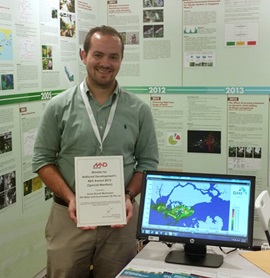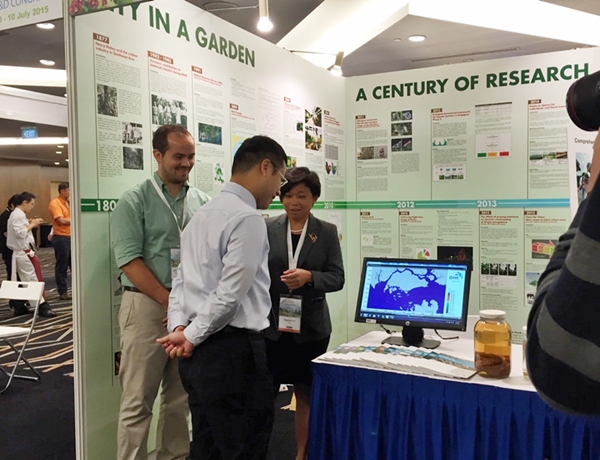Held 9-10 July 2015 at Suntec Singapore Convention & Exhibition Centre, the Congress – a platform for various agencies to discuss solutions to Singapore’s urban sustainability challenges – is a biennial event co-organised by the Ministry of National Development (MND) and partner agencies.

|
Mr Jonas Brandi Mortensen with the
MND Special Mention Award. |
As part of the congress, a total of 20 nominated R&D projects from various local government agencies, research institutes and private sector companies were judged by a panel of expert scientists. NParks in collaboration with DHI was presented with the ‘Special Mention’ award by the Minister of State, Ministry of National Development, Mr Desmond Lee. This award was for the work done by our environmental scientist – Jonas Brandi Mortensen – for innovation in using agent-based modelling (ABM) to determine ecological connectivity in the marine environment and to sustain marine biodiversity during coastal development.
We developed a probabilistic ABM for coral larvae dispersal and recruitment using ABM Lab, which is an integrated module in the ecological modelling software MIKE ECO Lab. MIKE ECO Lab is fully integrated within the MIKE Powered by DHI software suite and can thus accurately and dynamically represent hydrodynamics and water quality gradients within a spatially complex system while being fully coupled to the ABM of larvae dispersal and recruitment.
‘The coupled ABM approach allowed us to predict habitat and species connectivity within Singapore’s coastal waters’, says Jonas Brandi Mortensen, DHI’s Environmental Scientist who was at the helm of the modelling work. ‘The project findings have already paved the way for new DHI projects looking at seagrass connectivity as well as location optimisation for marine habitat enrichments for coral reefs in Singapore.’
The ABM of coral larvae dispersal can be readily applied to various areas in the management of coastal and marine environments, in particular in relation to land reclamation, offshore construction and conservation planning. Our modelling results supported NParks in crafting research and conservation plans for the Sisters’ Islands Marine Park, helping to safeguard the genetic diversity of Singapore’s coral population. The ABM approach can also play a part in the effective planning of coral reef restoration initiatives by identifying suitable areas for maximum restoration success.
 |
The Minister of State, Ministry of National Development, Mr Desmond Lee, being introduced to
the agent-based model by Dr Karenne Tun (NParks) and Jonas Brandi Mortensen (DHI).
|